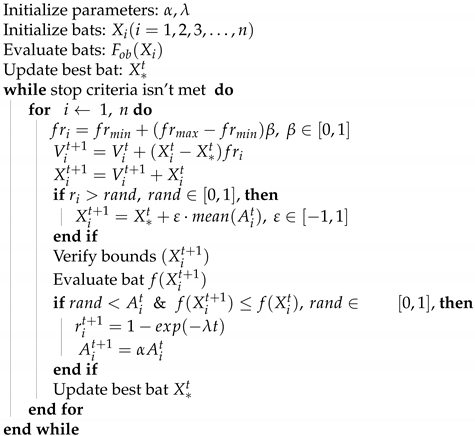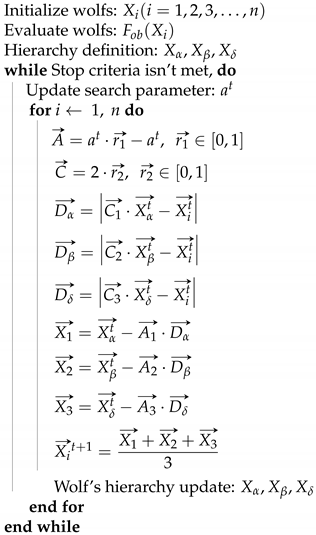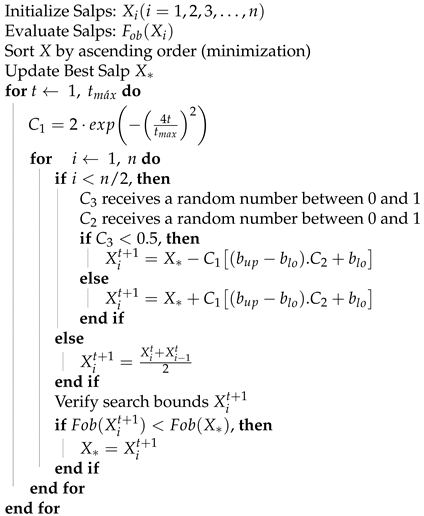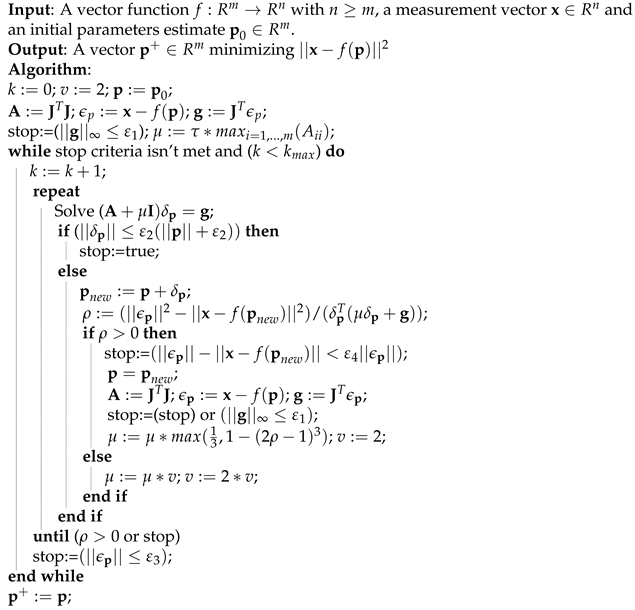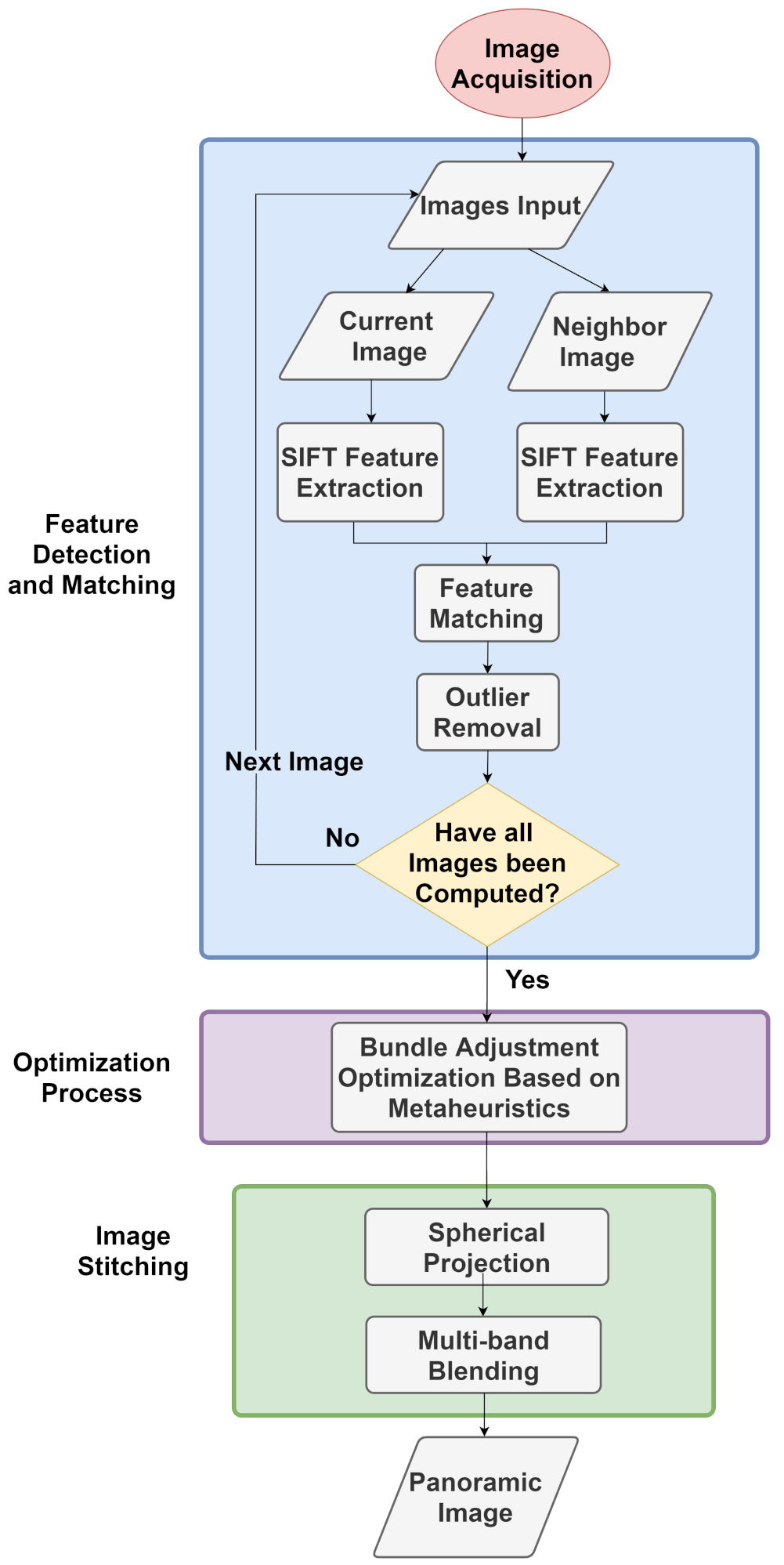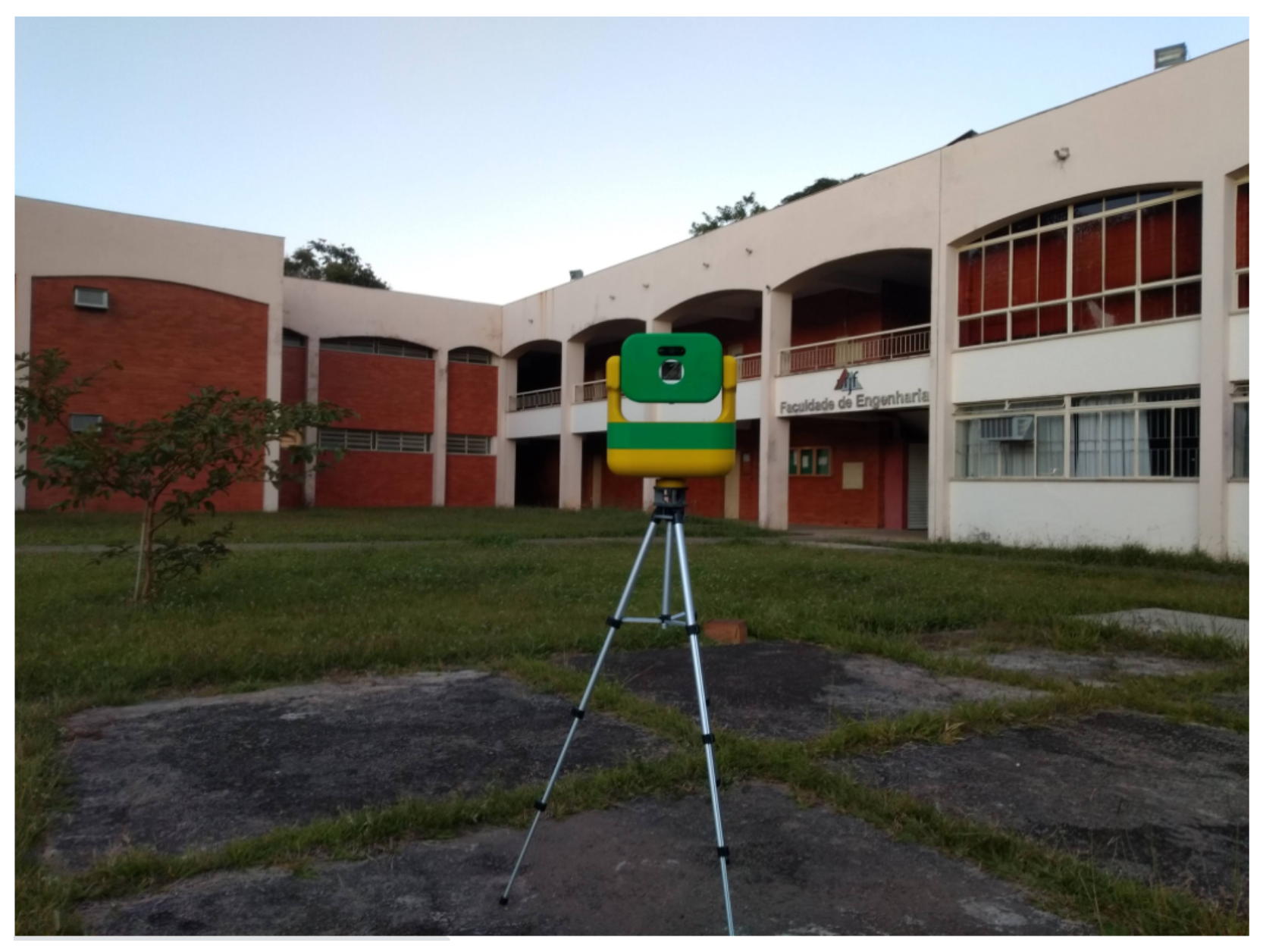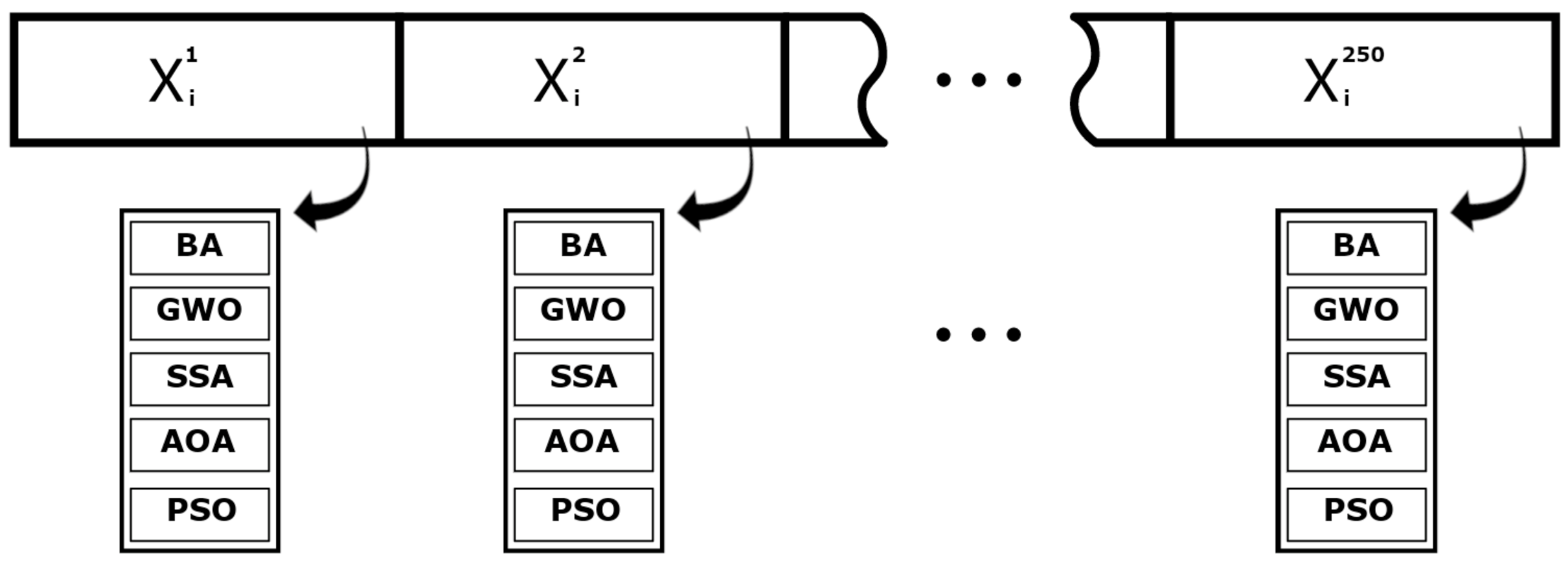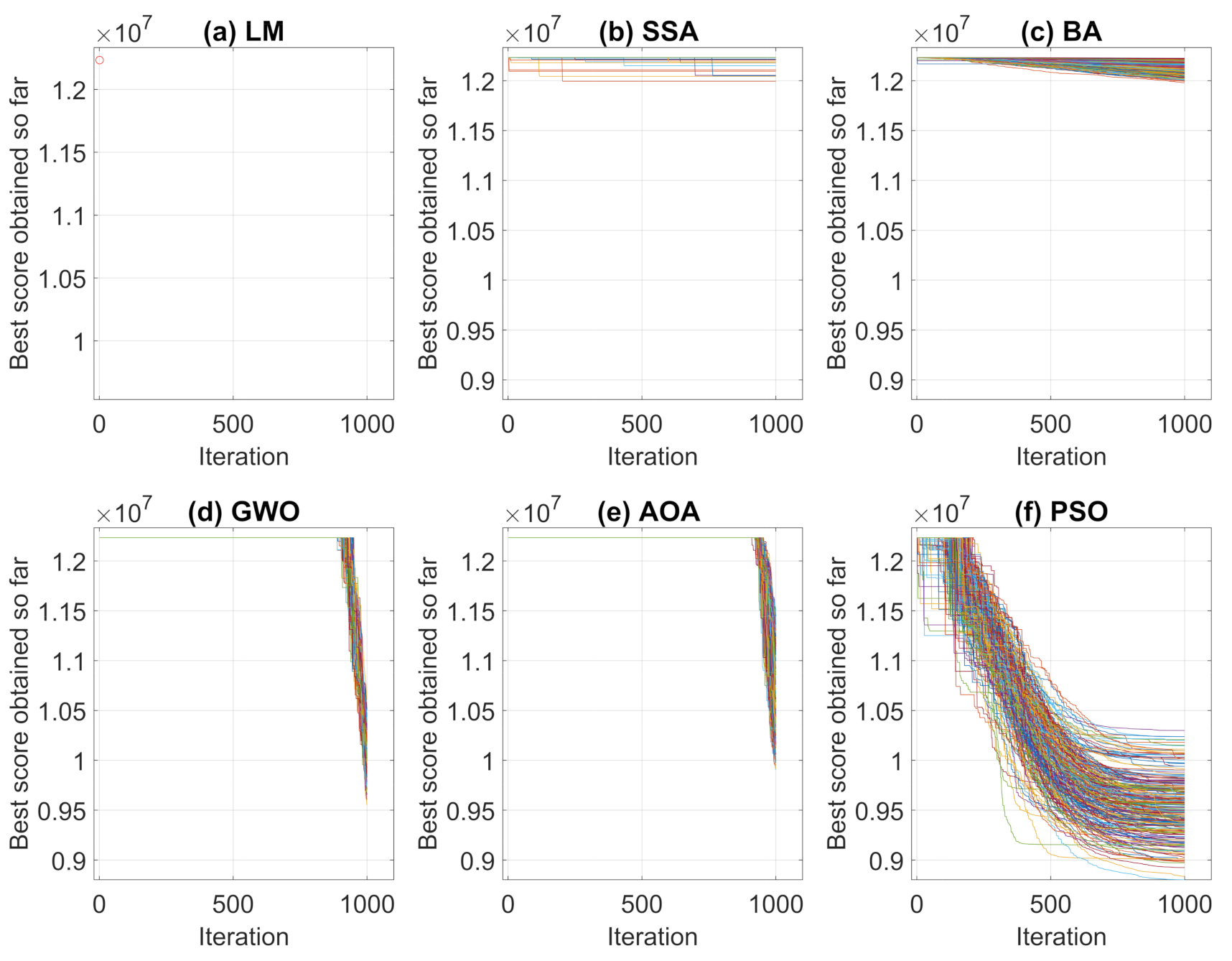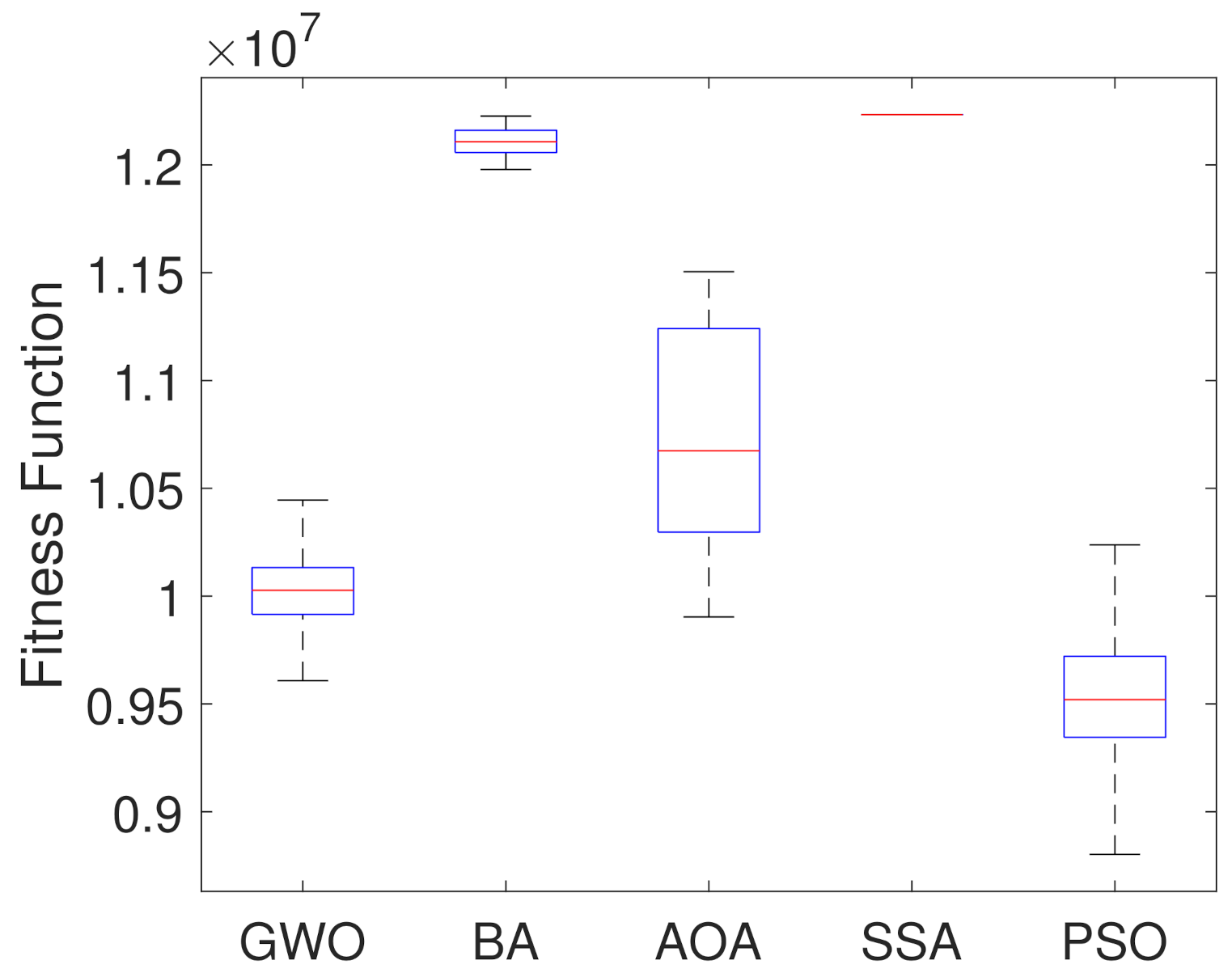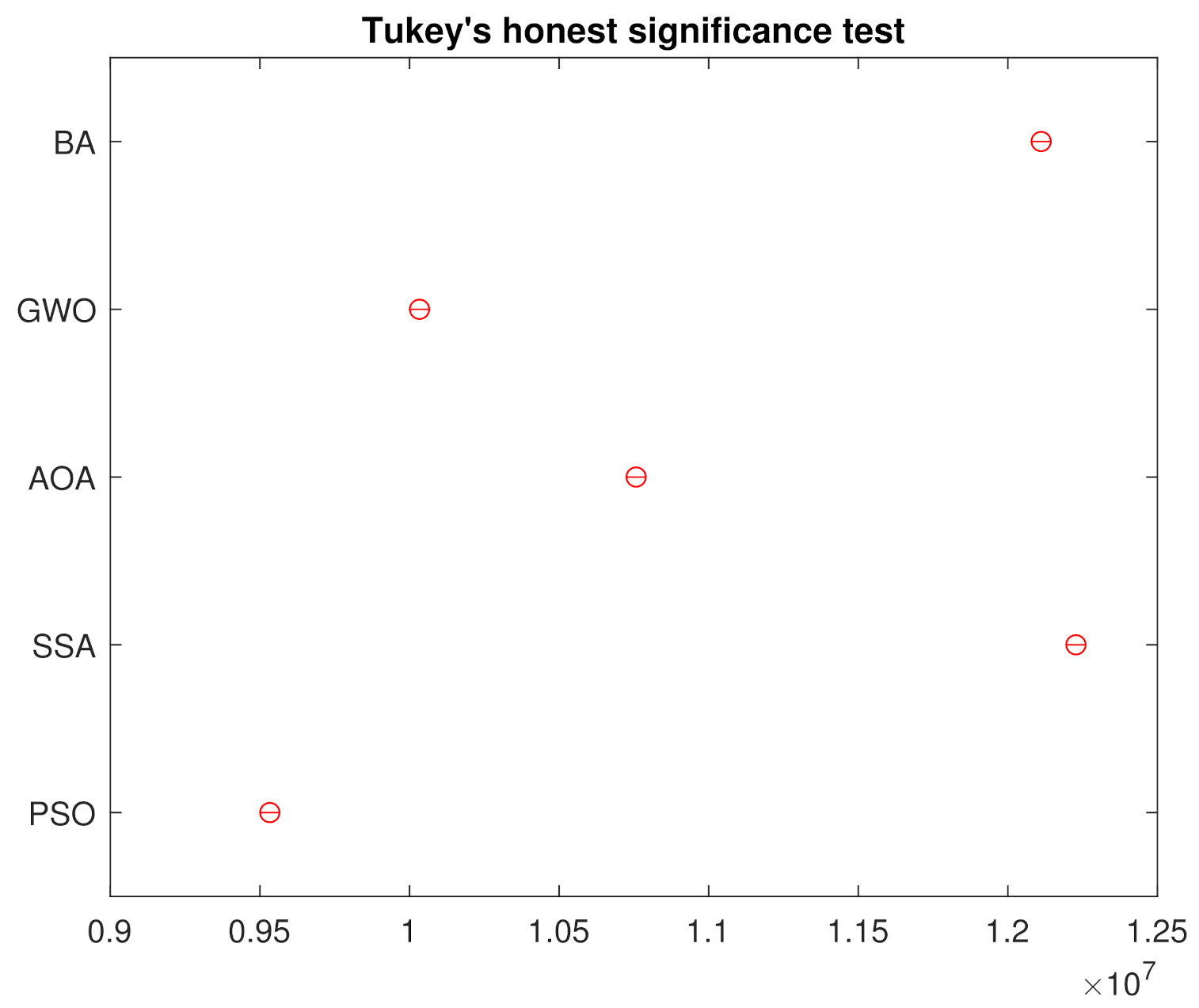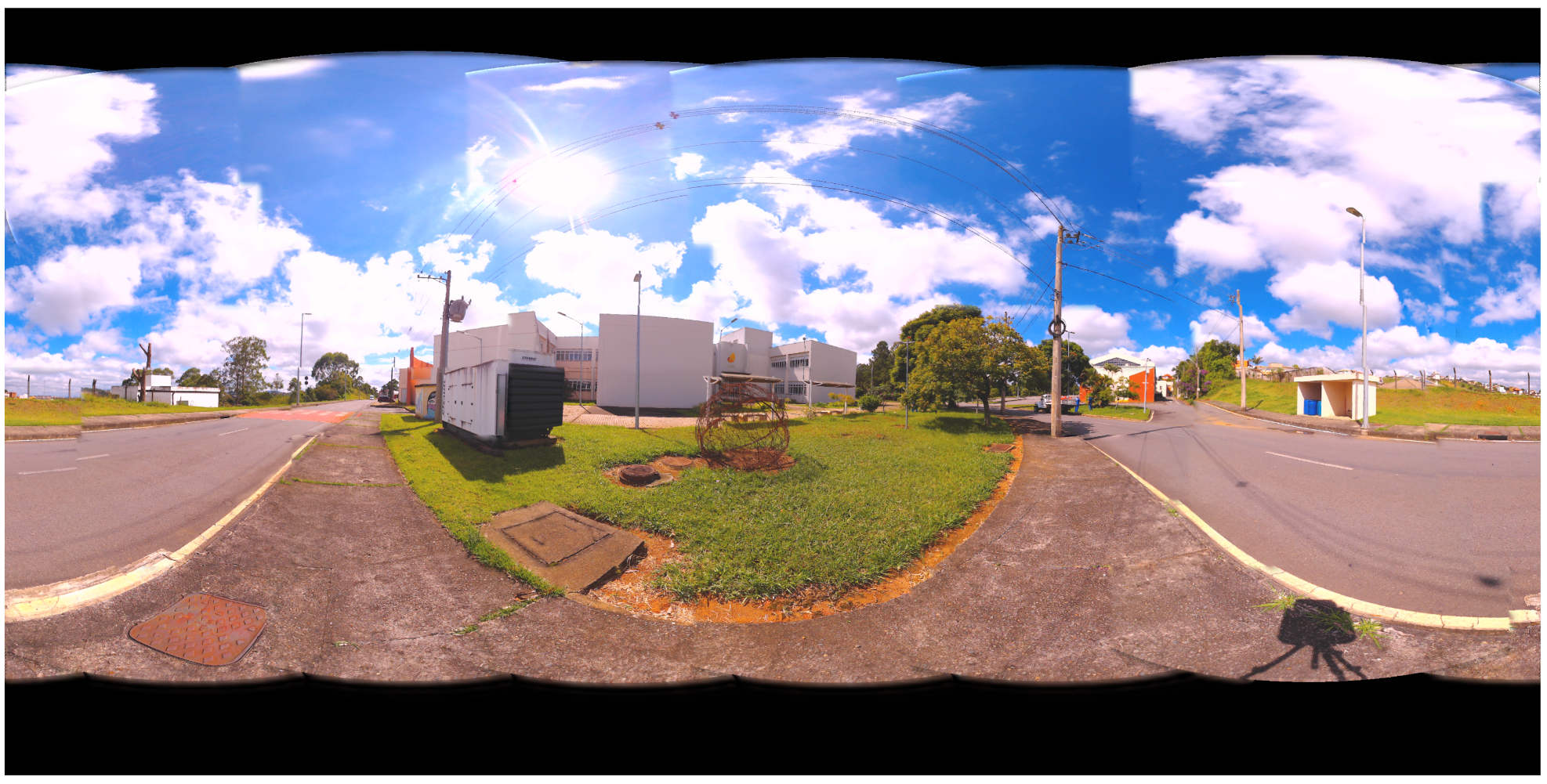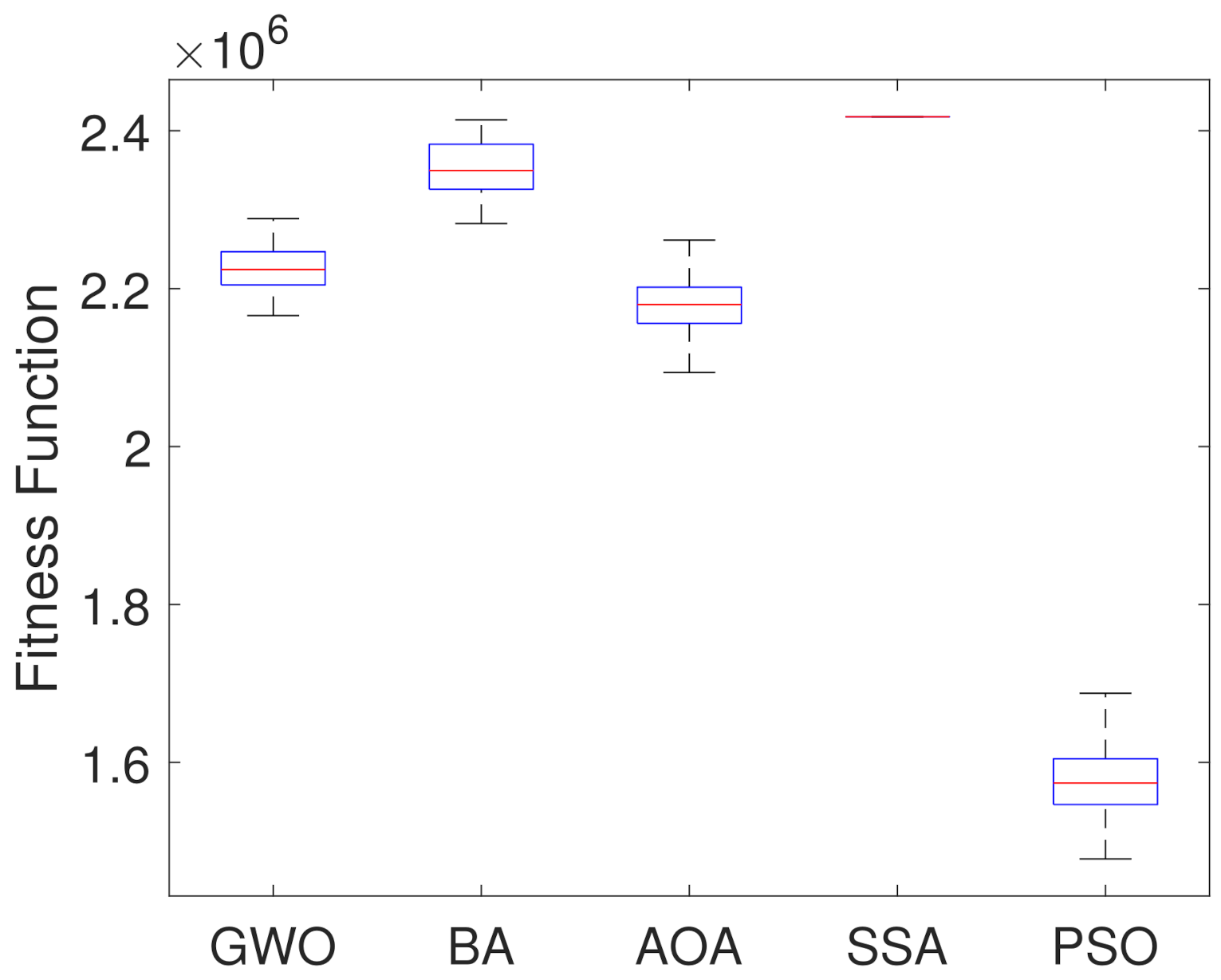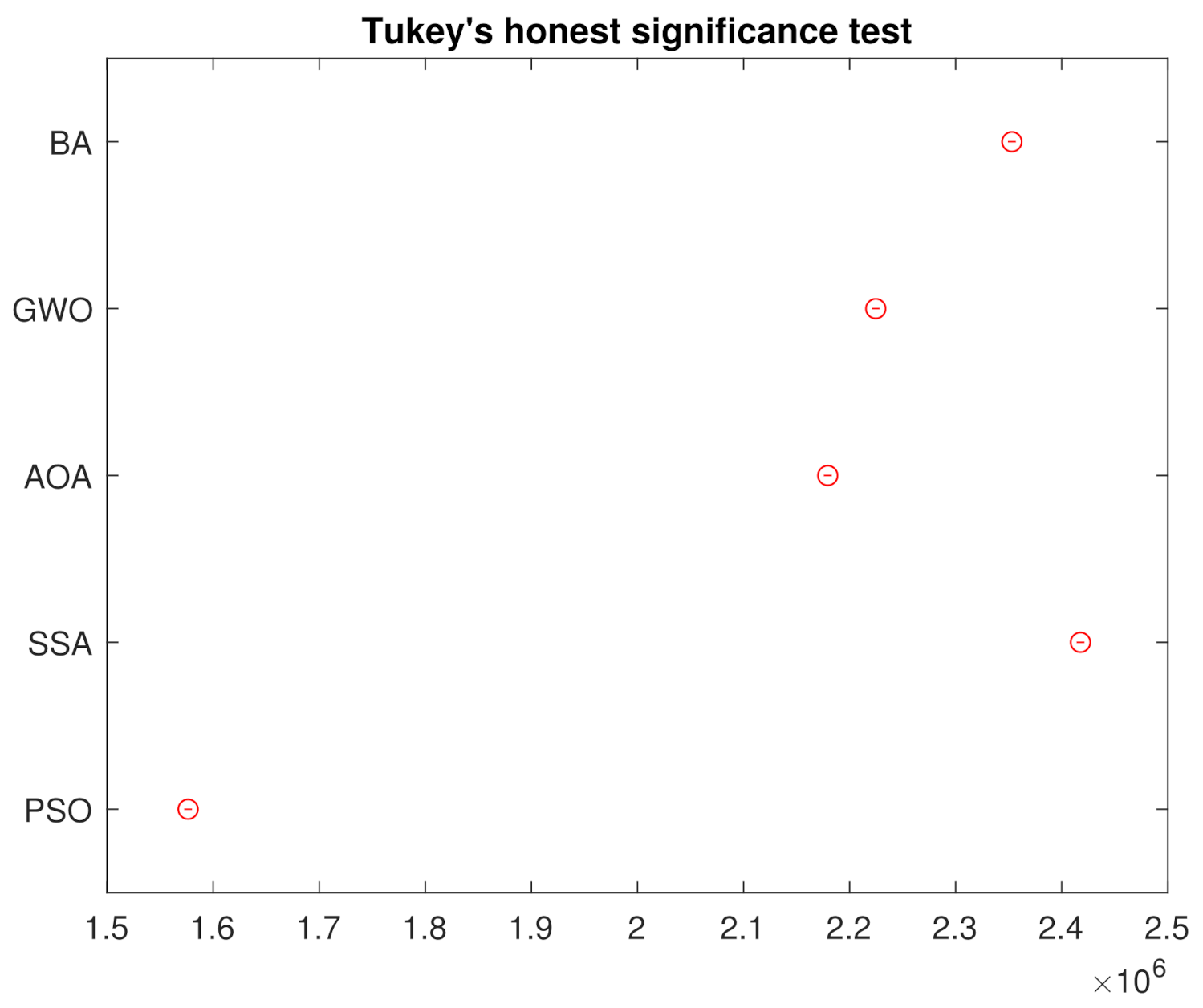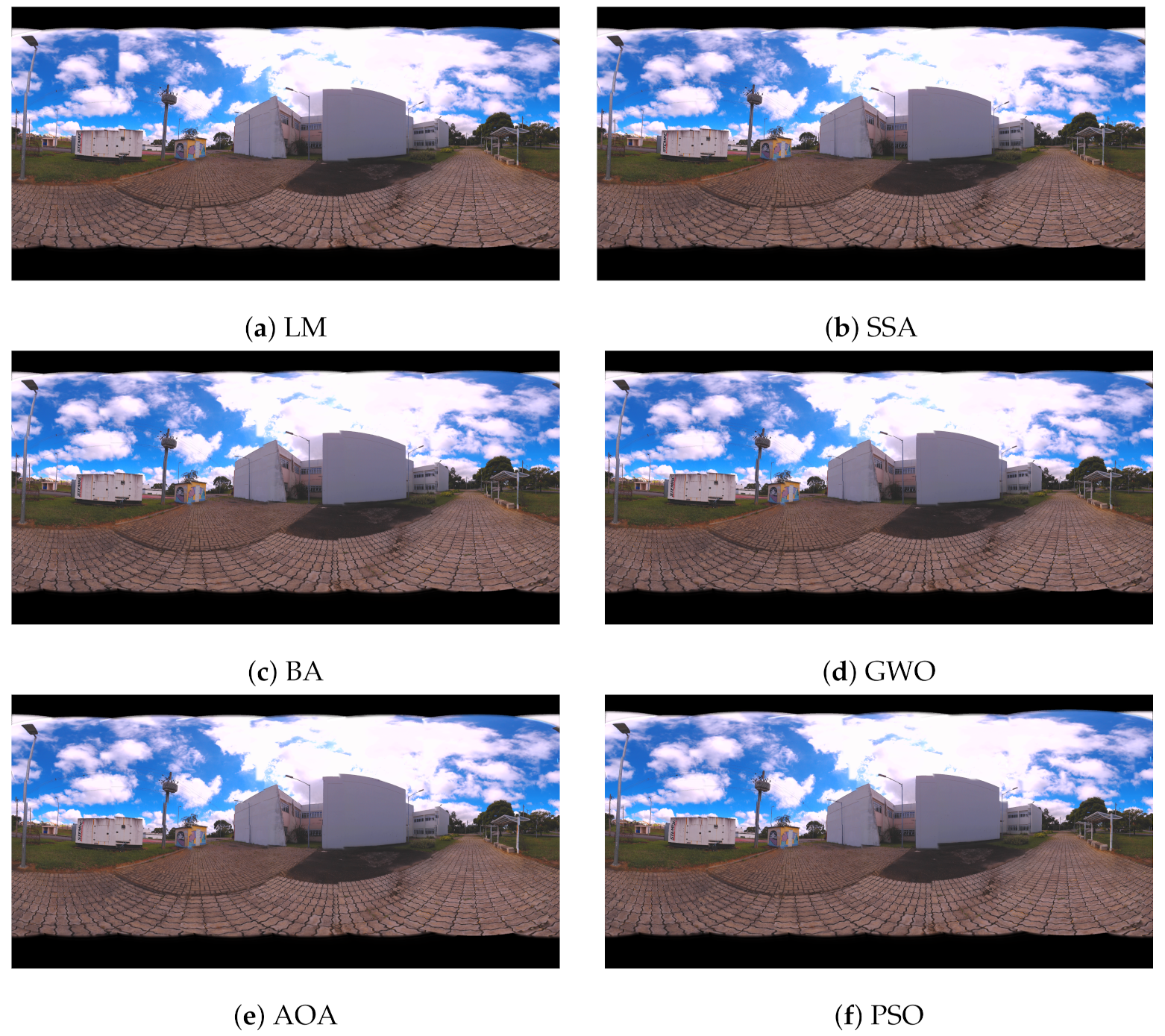This section presents the obtained results for each proposed optimization method, and some discussions about them. The simulations were conducted by using an Intel Core i7-7700HQ CPU 2.80 GHz computer with 16 GB of RAM and Windows 10 64-bit operating system. The proposed method was implemented in C++ programming language.
The proposed approaches are applied to image data from the Arts and Design School at the Federal University of Juiz de Fora, Brazil, from two different points of view, and compared with the Levenberg–Marquardt methodology.
Figure 4 presents two points off view generated from the original image acquisition data.
3.1. Case Study I
The performance of BA, GWO, AOA, SSA and PSO are compared with respect to: (i) the final value of the objective function; (ii) convergence; (iii) boxplots of the results and (iv) statics indices. In addition, the results are analyzed with respect to that obtained by the classical Levenberg–Marquardt method.
Performing the algorithms described in
Section 2, convergence curves and average convergence for the metaheuristic algorithms were obtained as shown in
Figure 5 and
Figure 6.
Figure 5 shows the convergence history of each algorithms for the 250 simulations performed and
Figure 6 shows the average curve of all convergence curves from all simulations.
Analyzing the responses obtained by the convergence curves presented in
Figure 5 and
Figure 6, it can be seen that in Levenberg–Marquardt method, the initial point interferes with the final solution, and as the initial guess is equal to the solution acquired by the robot, the method converged to the same solution, i.e., the solution presented is already a local optimum point. Therefore, the presented metaheuristics obtained a better response, since they found new solutions with objective function values of less than the initial one. When comparing the metaheuristics, the techniques convergence verifies that PSO and BA present a better global search stage compared to the others methods. That is, at process beginning, the algorithms perform an exploration of solution region and find good solutions. Meanwhile, GWO and AOA obtained similar convergence characteristics by having their differential in the local search step.
For further analysis, boxplot test is carried out for all the considered algorithms. They are presented in
Figure 7, showing the objective function optimal values considering a set of 250 simulations.
Table 2 presents statistical indices like median, mean and standard deviation of the fitness value acquired. They can be used to explain the information enclosed in the boxplot figure, and also present the average time (computational effort) in seconds of each algorithm.
Based on results in
Figure 7 and
Table 2, it can be noticed that PSO Algorithm outperforms the other metaheuristic algorithms in the optimization by presenting the lowest median, mean and fitness values. On the other hand, SSA showed the worst results. Although the Bat algorithm presents the second highest median value, it presents a smaller dispersion of the data, which indicates stability in the results, while the Arithmetic Optimization Algorithm presents greater variation.
Table 2 indicates that the computation time values of all algorithms are similar to each other.
In order to reject the null hypothesis, a variance test analysis is done, with results are shown in the
Table 3. For further comparison, a Tukey’s honest significance was also done and the results in
Figure 8 assures that the groups are all different from each other.
Panoramic images are obtained from the values found by the algorithms. In
Figure 9, the panoramas generated by the results of LM, AOA, GWO and SSA methods are shown.
Figure 10 illustrates the 360 panorama that obtained the best solution found by the PSO Algorithm.
For a clearer visualization, some improvements in the objective function can be visualized in the zoomed figures of the artifacts present in the comparison between the LM (inner black square) and PSO (inner green square) optimized images in
Figure 11. Four spots were chosen to represent the difference (red, cyan, yellow and dark blue squares). The details are shown below in the same figure.
Even with these improvements, the Panorama image is still not perfect and show some artifacts and misalignment because of the multimodal nature of the Bundle adjustment problem. More image processing procedures can further be used to enhance this panorama’s results. Although there is clear statistical improvement of the objective function, the RGB image still can be modified to become a more visually appealing panorama. In that regard, more procedures could further be used to enhance the panorama’s results and are still under investigation.
3.2. Case Study Ii
The same analyses of Case Study I, presented in
Section 3.1, were performed for Case Study II. Therefore, the results of convergence and average convergence curve of the methods can be seen in
Figure 12 and
Figure 13.
For this case, Levenberg–Marquardt’s behavior converging to the initial local minimum solution is also notorious. Analyzing the convergence curves of the other methods, it is observed that, the Particle Swarm Optimization and Bat techniques present a better global search in the solution, while Grey Wolf Optimizer and Arithmetic Optimization Algorithm have their prominence in the local search. The Salp Swarm Algorithm in all simulations, on the other hand, kept the fitness value equal to the original, that is, the algorithm did not find better solutions during iterations.
Figure 14 presents the boxplots of all methods considering the minimum values found in the 250 simulations.
Table 2 presents the statistical data for better results analysis obtained by the boxplots and the average computational efforts in seconds for each algorithm.
Analyzing the results of the
Figure 14 and
Table 4, it can be seen that the PSO Algorithm presented the smallest objective function value as well as median and mean, but in relation to the others it presented the largest standard deviation. The Grey Wolf optimizer presented the smallest dispersion of the data. On the other side, Salp Swarm Algorithm performed the worst result, not improving the solution.
Table 4 indicates that the computational time values of all algorithms are similar to each other.
In order to reject the null hypothesis, an analysis of variance test is done, and the results are shown in the
Table 5. For further comparison, a Tukey’s honest significance was also done and the results in
Figure 15 assures that the groups are all different from each other.
Panorama Results
The results of optimization algorithms are shown in
Figure 16 and
Figure 17 by means of the panoramic images generated.
Figure 16 presents the panoramic results of LM, SSA, BA, GWO, AOA and PSO methods.
Figure 17 illustrates the 360 panorama that obtained the best solution found by PSO Algorithm.
For a clearer visualization, some improvements in the objective function can be visualized in the zoomed figures of the artifacts present in the comparison between the LM (inner black square) and PSO (inner green square) optimized images in
Figure 18.
Although the panorama improved, the image is still not perfect and show some artifacts and misalignment that might be caused, in the same way as in case I, by the multimodal nature of the Bundle adjustment problem. Even though there is statistical improvement of the objective function, the RGB image still has room for improvement. In addition, more procedures could further be used to enhance the panorama’s results and are still under investigation.
